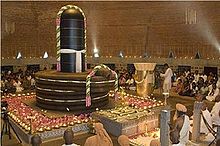- Dhyanalinga
-
The Dhyanalinga is a Yogic temple located 30 km (19 mi) from Coimbatore, India. The temple was consecrated by Sadhguru Jaggi Vasudev, a yogi and mystic. The temple is consecrated using prana prathista and is dedicated for meditation. Silence is maintained inside the temple. Dhyana in the Sanskrit language, means meditation and linga means form. Dhyanalinga is claimed by the owners of the temple to be a powerful and unique energy form created from the distilled essence of yogic sciences and the first of its kind to be completed in over 2,000 years.[1] The Dhyanalinga Yogic Temple offers a meditative space that does not ascribe to any particular faith or belief system.[2]
Contents
Architecture
A large ellipsoidal dome covers the sanctum sanctorum. The dome was constructed using only bricks and cement stabilized mud mortar without, steel or concrete.[3]
The dome is 76 ft (23.2 m) in diameter and 33 ft (10.1 m) in height. The lingam is 13 ft (4 m) in height made of high density black granite.
The Sarva Dharma Sthamba, located at the front entrance, functions as an icon of singularity, with the sculptural reliefs and symbols of Hinduism, Islam, Christianity, Jainism, Taoism, Zoroastrianism, Judaism, Buddhism, and Shinto inscribed as a universal welcome.
Theerthakund
A subterranean tank located 35 ft (10.7 m) below holds a lingam immersed in water. Followers claim that the lingam is made of solidified and 99.8% purified mercury. The mercury is said to have been solidified at room temperature. Mercury has a Freezing point of −38.83°C at atmospheric pressure, but ancient Indian alchemy claims to have techniques to do so. These methods are said to have been used by yogis to solidify the lingam at room temperature.[4] People can take a dip in this water before they go to the Dhyanalinga temple. A semi-circular brick vault covers this tank, the inner sides of which have murals in pure natural dyes with its theme depicting a Maha Kumbha Mela scene.
Events
Nadha Aradhana
An offering of sound to the Dhyanalinga, an etheric blend of vocals, singing bowls, drums and various other instruments amplified within the reverberating dome, transports one into the timeless space. This enhances one’s receptivity to the energies of Dhyanalinga.
Aumkar Meditation
Visitors coming to the Dhyanalinga, can further their experience by attending this daily initiation to the universal and powerful mantra "AUM." This meditation is known to have transcendental qualities. Meditation can bring peace and balance to the one’s system, and is known to relieve people from numerous physical and mental ailments when practiced regularly.[5][6][7]
The Dhyanalinga offers a unique set of activities throughout the year aimed at creating and promoting universal values and religious harmony. Daily activities include non-lyrical chants, offered by a talented group of singers, originating from various countries and cultures. These chants allow one to become more receptive to the meditative quality of the space. The focal point of Isha Yoga Center, the Dhyanalinga Yogic Temple is rapidly gaining in its global reputation as being one of the most sought out places for meditation.[2]See also
References
- ^ Sadhguru Jaggi Vasudev: "Dhyanalinga: The Silent Revolution", Isha Foundation, 2000, ISBN 978-8187910008
- ^ a b Rangaswamy, Sudhakshina (25 July 2003). "Transformation of the inner Self". The Hindu. http://www.hindu.com/fr/2003/07/25/stories/2003072501630600.htm. Retrieved 4 June 2011.
- ^ "Auroville Earth Institute, training courses, workshops on Vaults, Arches, Domes(VAD), stabilized rammed earth walls, compressed earth blocks, vaulted structures, compressed stabilised earth blocks, rammed earth.". http://www.earth-auroville.com/index.php?nav=menu&pg=vault&id1=36&txt=text.
- ^ Sadhguru Jaggi Vasudev: "Encounter the Enlightened: Conversations with the Master", Wisdom Tree, 2004, ISBN 978-8186685600
- ^ Bonadonna, R. (2003), "Meditation's impact on chronic illness", Holistic Nursing Practice, pp. 309–319, ISSN 0887-9311
- ^ Davidson, R.J.; Kabat-Zinn, J.; Schumacher, J. (2003), "Alterations in brain and immune function produced by mindfulness meditation", Psychosomatic Medicine, pp. 564–570, ISSN 0033-3174
- ^ Davidson, R.J.; Lutz, A. (2007), "Buddha's brain: neuroplasticity and meditation", Signal Processing, IEEE, pp. 171–174, ISSN 1053-5888
External links
Categories:- Hindu temples in Coimbatore district
- Hindu temples in Tamil Nadu
- Shiva temples
- Hindu pilgrimage sites
Wikimedia Foundation. 2010.

